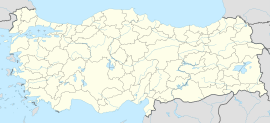Başakköy, İdil
Başakköy | |
|---|---|
| Coordinates: 37°21′32″N 41°42′58″E / 37.359°N 41.716°E | |
| Country | Turkey |
| Province | Şırnak |
| District | İdil |
| Population (2021)[1] | 124 |
| Time zone | UTC+3 (TRT) |
Başakköy (Kurdish: Basaqê, Syriac: Bēth Isḥaq)[2][a] is a village in the İdil District of Şırnak Province in Turkey.[4] The village is populated by Kurds of the Domanan tribe and had a population of 124 in 2021.[1][5] It is located in the historic region of Tur Abdin.[6]
In the village, there is a church of Mar Addai.[7]
History
[edit]Bēth Isḥaq (today called Başakköy) was historically inhabited by Syriac Orthodox Assyrians.[8] In 1394/1395, it was attacked by Amiran-shah, son of Timur, following the destruction of Diyarbakır, and the villagers took refuge in the village's citadel, according to the account of the priest Addai of Beth Sbirino in c. 1500 appended to the Chronography of Bar Hebraeus.[9] The citadel was seized, however, after its southern wall was undermined and destroyed and the men were killed whilst the women and children were taken captive.[10] It was later also attacked by Bakhti Kurds in 1453 alongside the neighbouring villages of Beth Sbirino, Midun, and Araban.[11] The Bakhti Kurds attacked Bēth Isḥaq, in addition to the villages of Midun and Araban, again in 1457 and settled there.[12]
Yuhanna Murad, Syriac Orthodox metropolitan bishop of Qartmin, (r. 1785–1800) was from Bēth Isḥaq.[13] It was resettled by Christians in c. 1870 and was wholly inhabited by Christians in the late nineteenth century.[14] In 1914, there were 120 Assyrians, as per the list presented to the Paris Peace Conference by the Assyro-Chaldean delegation.[15] It was located in the kaza (district) of Midyat.[15] 20 Assyrian families inhabited Bēth Isḥaq in 1915.[16] Amidst the Sayfo, a number of villagers sought protection at Beth Sbirino and Midun whilst Bēth Isḥaq itself was destroyed.[14] The church of Mar Addai was converted into a barn by 1978.[14] By 1987, there were no remaining Assyrians.[16]
References
[edit]Notes
Citations
- ^ a b "31 ARALIK 2021 TARİHLİ ADRESE DAYALI NÜFUS KAYIT SİSTEMİ (ADNKS) SONUÇLARI" (XLS). TÜİK (in Turkish). Retrieved 16 December 2022.
- ^ Palmer (1990), p. xxi.
- ^ Gaunt (2006), p. 206; Barsoum (2008), p. 15; Jongerden & Verheij (2012), p. 321; Courtois (2004), p. 226; Keser-Kayaalp (2022), p. 112.
- ^ "Türkiye Mülki İdare Bölümleri Envanteri". T.C. İçişleri Bakanlığı (in Turkish). Retrieved 19 December 2022.
- ^ Baz (2016), p. 148.
- ^ Barsoum (2008), p. 15.
- ^ Barsoum (2008), p. 18.
- ^ Jongerden & Verheij (2012), p. 321.
- ^ Barsoum (2008), pp. 68, 75–76; Keser-Kayaalp (2022), p. 112.
- ^ Barsoum (2008), pp. 68, 75–76.
- ^ Barsoum (2008), p. 70.
- ^ Barsoum (2008), p. 71; Keser-Kayaalp (2022), p. 112.
- ^ Barsoum (2008), pp. 35, 51.
- ^ a b c Gaunt (2006), p. 206; Keser-Kayaalp (2022), p. 112.
- ^ a b Gaunt (2006), p. 427.
- ^ a b Courtois (2004), p. 226.
Bibliography
[edit]- Barsoum, Aphrem (2008). The History of Tur Abdin. Translated by Matti Moosa. Gorgias Press. Retrieved 1 April 2021.
- Baz, Ibrahim (2016). Şırnak aşiretleri ve kültürü (in Turkish). p. 148. ISBN 9786058849631.
- Courtois, Sébastien de (2004). The Forgotten Genocide: Eastern Christians, The Last Arameans. Translated by Vincent Aurora. Gorgias Press. Retrieved 20 November 2024.
- Gaunt, David (2006). Massacres, Resistance, Protectors: Muslim-Christian Relations in Eastern Anatolia during World War I. Gorgias Press. Retrieved 21 May 2023.
- Jongerden, Joost; Verheij, Jelle, eds. (2012). Social Relations in Ottoman Diyarbekir, 1870-1915. Brill. Retrieved 20 November 2024.
- Keser-Kayaalp, Elif, ed. (January 2022). Syriac Architectural Heritage at Risk in TurʿAbdin (PDF). Retrieved 8 November 2024.
- Palmer, Andrew (1990). Monk and Mason on the Tigris Frontier: The Early History of Tur Abdin. Cambridge University Press. Retrieved 15 July 2020.

